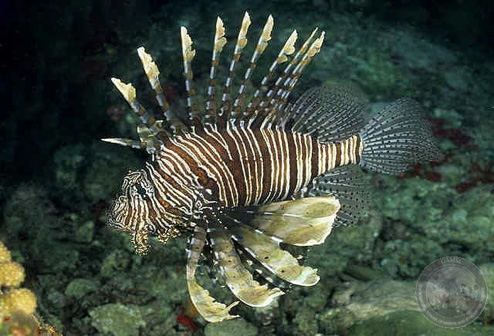Lionfish Information
Lionfish belong to the Pterois genus. Other common names for lionfish include fire fish, zebrafish, and turkey fish, and there are currently 8 recognized species of lionfish from the Pacific region. Strictly a marine species, lionfish are native to the Indo-Pacific, but they are now found in the Atlantic where they are considered an invasive species. Lionfish can be found anywhere from 1 to 300 feet deep along mangroves, coral reefs, artificial reefs, seagrass beds, and the hard bottom of the ocean.

Lionfish have stripes of white and brown or maroon, fleshy tentacles above the eyes and below the mouth, cycloid scales, fan-like pectoral fins, and long, separated and venomous dorsal spines. The venom glands of a lionfish are located within two grooves of the spine. This venom is a combination of protein, a neuromuscular toxin and a neurotransmitter called acetylcholine. Exposure to the venom only occurs if a spine pierces the skin and the venom gland becomes exposed to the wound. If a human is stung by a lionfish, they should seek medical help immediately. Lionfish stings are nonfatal to humans, but the toxin introduced into the human body can last for days and cause extreme pain, sweating, respiratory distress, and even paralysis as reported in documented cases.
Found in both a solitary state or in small group settings, wild lionfish can live to be around 16 years old. A female will lay anywhere between 2,000 and 15,000 eggs for the male to fertilize. The fertilized eggs will then float to the surface and hatch after only 2 days.
Lionfish are mostly sedentary and stay within a small territory. They swim slowly and hide in crevices and on ledges for safety when needed. They are still active predators though who overstretch their fan-like pectoral fins to ambush and corner their prey. Presumably, lionfish came to inhabit the Atlantic after they were brought over to United States aquariums. They are popular for aquariums because of their beauty. While originally they had no natural predators in the Atlantic, groupers and sharks may slowly becoming opportunistic predators. Ultimately, humans are the most effective natural predators of the lionfish. Spearfishing lionfish is both a popular method of control and sport. Lionfish can be prepared and consumed but are rarely a regular restaurant item. In the wild, these fish can be defensive, but not necessarily aggressive. They sit still well for underwater photographers. Myron Wang, founder of the DAMSL project has “50 years of experience as an underwater photographer and made over 4,000 ocean dives.” He’s had the pleasure of observing many of these gorgeous fish up close. Myron says, “I have seen and photographed the same lionfish which resided on the stern of the sunken Shinkoko Maru in the Truk Lagoon during three separate dive trips spanning ten years.” Not only an interesting bit of information, this further supports that lionfish appear to overtake only a small area and don’t move around once introduced to an area that will support them.
